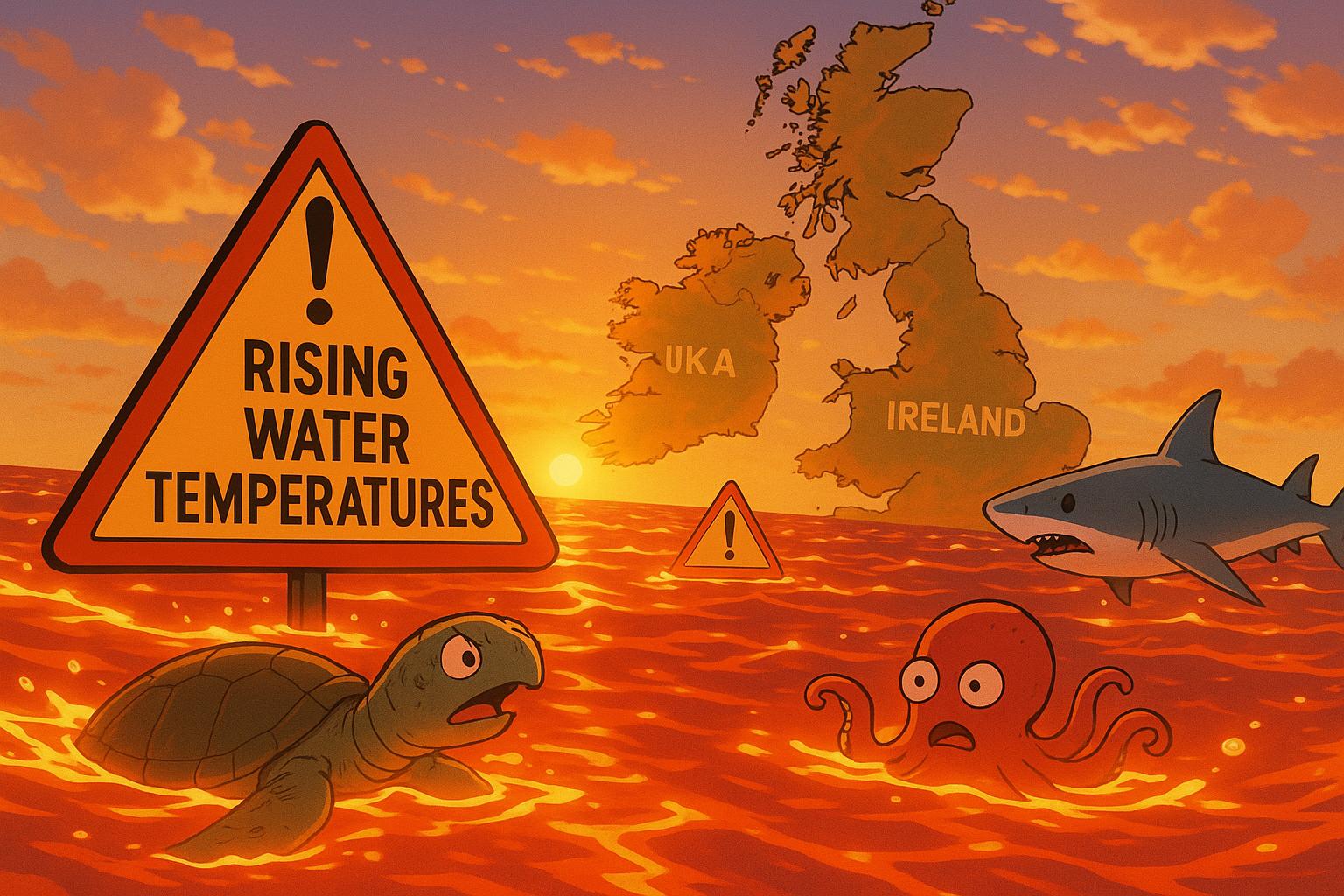Sea temperatures around the UK and Ireland have surged up to 4°C above average, marking the highest levels in 45 years as an unprecedented marine heatwave coincides with climate change and El Niño, raising concerns over marine ecosystems and future weather patterns.
Sea temperatures around the UK and Ireland have surged to record highs, a phenomenon attributed to an unprecedented marine heatwave. Recent data reveals that some areas are experiencing temperatures as much as 4°C above the seasonal average, particularly around the west coast of Ireland, Cornwall, and Devon. This spike in sea temperatures has significant implications for marine life and recreational activities. According to scientists at the National Oceanography Centre and the Met Office, April and May have recorded the highest sea temperatures for these months in 45 years of monitoring.
The buoyant heat, exacerbated by one of the warmest Springs on record, has led to concerns within the scientific community. Dr Ségolène Berthou from the Met Office noted, “It’s super intense at the moment. The marine heatwave has really soared this week.” Additionally, Dr Zoe Jacobs of the National Oceanography Centre highlighted that unusual marine temperatures had been observed as early as late 2024, indicating a prolonged period of warmth before peaking this month. Marine heatwaves are classified by sustained temperatures exceeding seasonal thresholds for over five consecutive days, and the current averages have indeed surpassed these benchmarks.
The implications for marine ecosystems are particularly concerning. Dr Jacobs pointed out that while the temperatures have not reached levels harmful to species survival, there is a risk of disrupted breeding patterns among marine life. Warmer waters may also lead to an influx of jellyfish, particularly the barrel jellyfish, alongside potentially harmful algae blooms, which can threaten other marine species. Historical data supports these worries, with the massive mortality of mussels in past heatwaves and a 32% increase in jellyfish sightings during similar phenomena in 2023.
Moreover, the current conditions are not isolated but rather part of a broader, alarming trend. The North Atlantic Ocean has seen sea surface temperatures rise significantly, with the US National Oceanic and Atmospheric Administration categorising parts of the North Sea as a category four marine heatwave, classified as ‘extreme.’ Research indicates that these sea temperatures are not only reflective of local conditions but are also somewhat influenced by global trends, as human-induced climate change continues to escalate ocean warming.
The impact of this marine heatwave extends beyond marine biodiversity. Higher sea temperatures can influence terrestrial weather, as warm seas can lead to elevated land temperatures — a trend observed as recently as May 2024, where sea breezes contributed significantly to unusual land heat patterns. Looking beyond the immediate effects on wildlife, these temperature anomalies signal ongoing environmental shifts.
While historical records highlight the potential for severe ecological impacts, the situation is further complicated by the arrival of the El Niño weather phenomenon, known to lead to heightened global ocean temperatures. The Met Office and other scientific bodies have raised alarms about this interplay between climate change and natural variability, suggesting that warmer seas may become a recurring issue rather than an isolated event.
As scientists continue to monitor the coastal waters, they are aware that marine ecosystems can be profoundly impacted. Research by the European Space Agency and the Met Office indicates a significant warming trend along the UK’s coastlines, compounding concerns about the future resilience of these waters. The situation serves as a stark reminder of the increasingly unpredictable nature of our climate, one that requires urgent attention and action.
In light of this marine heatwave, experts reiterate the necessity for ongoing research to better understand the potential long-term consequences for marine biodiversity and coastal communities. As we confront the reality of climate change, the narrative surrounding sea temperatures has moved from seasonal fluctuations to critical warning signs of a warming world. Scientists are left to ponder how far-reaching the effects of these changes will be in the years to come.
Reference Map
- Paragraphs 1-2
- Paragraphs 3-4
- Paragraphs 5-6
- Paragraph 7
- Paragraph 8
- Paragraphs 9-10
- Paragraph 11
Source: Noah Wire Services
- https://www.bbc.com/news/articles/c7533y6l3k0o – Please view link – unable to able to access data
- https://www.theguardian.com/environment/2023/jun/19/marine-heatwave-uk-irish-coasts-threat-oysters-fish-high-temperatures – An unprecedented marine heatwave off the coasts of the UK and Ireland poses a serious threat to marine life. Sea temperatures, particularly off the north-east coast of England and the west of Ireland, are several degrees above normal, breaking records for late spring and early summer. The Met Office reports that global sea surface temperatures in April and May reached an all-time high for those months, with June also on course to hit record heat levels. The US National Oceanic and Atmospheric Administration has categorized parts of the North Sea as being in a category four marine heatwave, considered ‘extreme’, with areas off the coast of England up to 5°C above usual temperatures. The Met Office attributes this warming partly to human-induced climate change, with other natural and man-made factors also contributing to the rise in temperatures. The emergence of the El Niño weather phenomenon is expected to keep temperatures high.
- https://www.bbc.co.uk/news/science-environment-65948544 – Seas around the UK and Ireland have experienced some of the most intense marine heat increases on Earth, with water temperatures up to 3 to 4°C above the average for this time of year. The European Space Agency (ESA) and the Met Office report that the sea is particularly warm off the UK’s east coast from Durham to Aberdeen, and off north-west Ireland. The Met Office attributes this warming partly to human-caused climate change, with other less-understood natural and man-made factors also contributing to the rise in temperatures. The ESA data shows that sea water around virtually the entire coastline of the British Isles is warmer than usual.
- https://www.yourweather.co.uk/news/trending/extraordinary-marine-heatwave-grips-uk-ireland-noaa-extreme-event-oceans-climate.html – An extraordinary marine heatwave is gripping the UK and Ireland, with sea surface temperatures in some coastal areas reaching 4-5°C above average for the time of year. The US National Oceanic and Atmospheric Administration (NOAA) has classified the heatwave as a category 4 extreme event. The North Atlantic Ocean has experienced record-breaking temperatures in recent months, with May temperatures soaring to 1.25°C above normal—the highest monthly anomaly in data going back to 1961. The situation in the North Atlantic is the most notable, with parts of the North Sea, the west coast of Ireland, and the south-west coast of England experiencing unusually warm waters. Off the coast of Cornwall, sea temperatures have climbed to between 17°C and 19°C in some places, which is highly unusual. The Met Office attributes this warming to a combination of natural variation and human-induced climate change. The recent arrival of El Niño, associated with warmer than average sea temperatures in the eastern Pacific, is likely to drive global sea temperatures towards further record values as the year progresses.
- https://www.sciencemediacentre.org/expert-reaction-to-global-sea-surface-temperatures-for-april-and-may-being-the-highest-on-record-for-those-calendar-months-in-a-series-stretching-back-to-1850-according-to-met-office-data/ – Experts have reacted to the news that global sea surface temperatures for April and May were the highest on record for those months in a series stretching back to 1850, according to Met Office data. The North Atlantic, including the seas around the UK, are exceptionally warm for this time of the year and have been on an unusual upward trajectory since mid-January. Sea surface temperatures to the east and west of the UK and Ireland are in places up to 4-5°C higher than normal and have been so for more than five days, leading the USA’s National Oceanic and Atmospheric Administration to classify this event as a level 4 marine heatwave, which is the ‘extreme’ category. While the specific causes of this event are not yet fully understood, it is likely due to a combination of human and natural causes. The oceans have already absorbed 90% of the excess heat due to anthropogenic greenhouse gases and continue to warm. At the same time, an El Niño is developing in the tropical Pacific, which is the warm phase of the Pacific’s natural cycle. During El Niño events, the global ocean tends to store more heat than usual. Experts expect warm temperature records to be broken more this year, both on land and sea across the globe.
- https://www.euronews.com/green/2023/06/20/meteorologists-observe-record-breaking-marine-heatwaves-off-uk-and-ireland – Meteorologists are monitoring what they believe to be record-breaking marine heatwaves off the northeast coast of England and northwest Ireland. Sea temperatures around the UK and Irish coasts are up to five degrees Celsius warmer than normal for this time of year, smashing records. Parts of the North Sea are in a category four ‘extreme’ marine heatwave, according to the US National Oceanic and Atmospheric Administration. Temperatures are particularly high around the north-east coast of England and the west of Ireland. Warming seas could bring jellyfish and basking sharks closer to the shore and cause poisonous algae to bloom. The marine heatwave has deeply concerned marine scientists. Bangor University physical oceanographer Thomas Rippeth stated that he has never known such temperatures at this time of year. He emphasized that the ocean does not heat up and cool down quickly; it takes a long time to warm up and cool down. Seeing these four or five-degree differences from the norm are significant temperature differences.
- https://www.newscientist.com/article/2378819-uk-and-ireland-suffer-one-of-the-most-severe-marine-heatwaves-on-earth/ – Ocean waters around the UK and Ireland are experiencing one of the most severe marine heatwaves on Earth, with temperatures up to 4°C above normal in some places. The North Atlantic Ocean has experienced record-breaking temperatures for the past three months, with average surface temperatures peaking on 17 June at 23°C, 0.2°C above the previous high set in 2010. Much of the heat is currently concentrated on waters surrounding the UK and Ireland, with scientists at the US National Oceanic and Atmospheric Administration categorizing the region as being hit by a category 4 (extreme) marine heatwave. Waters off the UK’s east coast, from Durham to Aberdeen, and off the west coast of Ireland are especially warm. Off Seaham, on the coast of Durham, water temperatures on 18 June hit 15°C, well above the 12°C average for the time of year.













